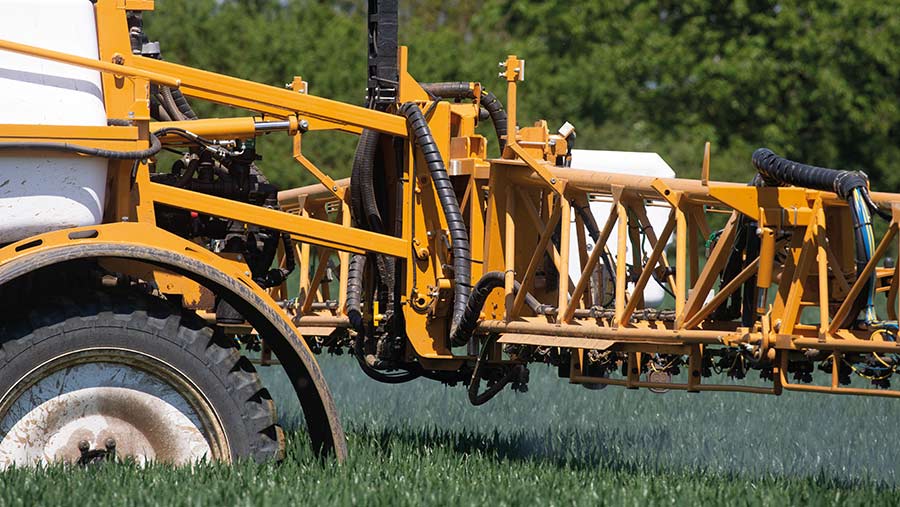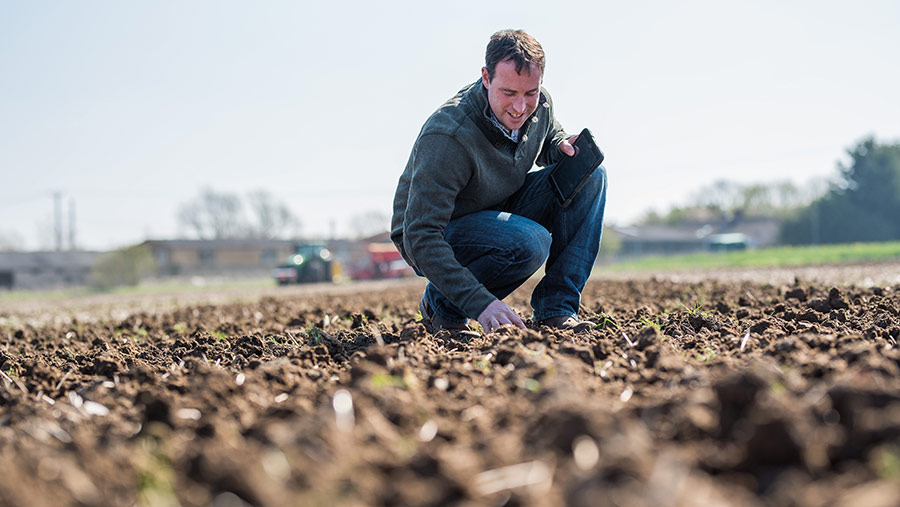Why questions remain over new fungicide performance in 2021
 © Tim Scrivener
© Tim Scrivener Septoria got off to a slow start in cold, dry spring conditions last year, but made up for lost time later in the season, with crops showing much more disease by June than in previous years.
There were many reasons for that, say agronomists – from variety resistance issues, loss of chemistry and the use of reduced rates, to weather-related delays to T2 applications which put greater emphasis on the curative properties of fungicides.
See also: 5 tips to tailor wheat fungicides to variable spring weather
Either way, septoria is not getting any easier to control and the protectant timing is becoming more critical, believes independent agronomist Jock Willmott of Ceres Rural.
He points out that rain in May 2021 was the catalyst for the septoria onslaught.
Rain before T2
“In most areas, the rain arrived just before the T2 timing, causing late infection events. That meant that the amount of eradicant activity in sprays became important.”
The Cougar strain of septoria that emerged last year also had a bearing on disease incidence and control results, he says.
“It took over very quickly and we saw varieties with Cougar parentage being affected, albeit not equally.”
It helps to explain why some varieties had higher levels of septoria than expected from their disease resistance ratings, but leaves questions about fungicide efficacy and persistence ahead of the new season, he says.
Key fungicide products
- Univoq – fenpicoxamid + prothioconazole
- Revystar – fluxapyroxad + mefentrifluconazole
- Ascra – bixafen + fluopyram + prothioconazole
- Aviator – bixafen + prothioconazole
- Elatus Era – benzovindiflupyr and prothioconazole
“In early 2021, there had been a move to cut back on fungicides and reduce rates, as there was very little septoria around.
“Those growers who didn’t apply enough at T1 found that their sprays had run out of protection by T2. That mattered once the rain arrived and delayed T2 sprays by a week or more.”
BASF’s Revystar was in its first full commercial year and most of it was applied at T2. For 2022, rates may need to be reconsidered, he suggests.
“If you’re using less than 1 litre/ha of Revystar, there’s always a risk that you won’t have enough eradicant activity if T2 is applied too late and not enough persistency if June and July are dull and wet, like last year. Last year’s trials results show it’s better at higher rates.”
Fungicide choice
Part way through the season, BASF’s Revystar was joined by Corteva’s Univoq, which was available in very limited quantities, having been approved in time for the flag leaf spray.
In the field, the 2021 season favoured the more persistent fungicides, which explains why a gap in performance emerged between the two top products in AHDB’s fungicide dose response work.
The two gave very similar results across three seasons in protectant situations, but Univoq edged ahead in a curative scenario.
Last year was in complete contrast to the year before, points out Ryan Hudson of Velcourt Agronomy, who recalls that the disease pressure ramped up significantly once the weather changed.
That made it important to get persistency from the T2 spray, so any treatments where rates had been undercooked were always up against it.
“There were three things at play last year, which combined to give some disappointing results – reduced rates, unsettled weather and varietal resistance shifts. The other influence was the dry April, which gave a false sense of security.”
Univoq may be the choice in higher disease pressure situations, he suggests, especially as crops are looking better at this stage of the year than they have for the past few seasons.
Higher rates and premium products will cost more, he acknowledges, and with fungicide prices expected to be 5-10% higher this year, budgets may have to rise.
“The past few years have seen a lower spend on fungicides, with £60-70/ha programmes performing well. This year, they will be closer to £100/ha.”
Case study: Richard Ling, Rookery Farm, Wortham

© AHDB
Diss Monitor Farm host Richard Ling always considers the likely return on investment when it comes to fungicide use and is very aware that the newer chemistry comes with a higher price tag.
He tried Revystar for the first time in 2021 at T2, after discussing the options with his agronomist and considering the disease resistance ratings of his chosen varieties, as well as looking at the weather forecast.
An unsettled spell in May, with rain falling every other day, meant that the septoria risk was rising as the T2 timing approached, he recalls.
No chlorothalonil
“It was in stark contrast to the previous year when it remained dry and there was very little disease around. The other relevant factor for 2021 was that chlorothalonil had gone from the toolkit,” points out Mr Ling.
With feed wheats Gleam and Saki in the ground, he opted to apply Revystar to the Gleam at the flag leaf timing on 25 May, using 0.9 litres/ha and adding in 0.5 litres/ha of tebuconazole, to bolster the yellow rust control.
“I was underwhelmed by its performance, to be honest,” he says. “After all the hype and marketing surrounding the product, together with its higher price, I expected more.”
His T1 spray, which had been applied at the optimum timing, was based on 0.6 litres/ha of Elatus Era, to limit any disease transfer up the plants and protect new leaves.
“Together, it seemed like a good programme which would keep our crops very clean. As the season ended, it became clear that wasn’t the case.”
This year, he is growing just over 200ha of Extase and Saki. After a mild winter, he notes that the risk of both septoria and yellow rust is much higher at this stage of the season and is making plans accordingly.
A weather station on the farm with disease modelling will be used to help with his decision making and eliminate guesswork.
This season
Mr Ling’s plan for 2022 is to switch some of his area to Univoq at T2. Having seen the new product in trials, he believes it is more robust than existing choices and will help to protect the other chemistry used throughout a disease control programme.
Due to inflationary pressures, he is reluctantly increasing his fungicide budget by around 10% this year. “I am trying to hold firm, but input costs have risen across the board and I need to factor that in.”
He adds that he still expects to see a good return on his investment in fungicides, but points out that newer chemistry is much more expensive.
“At such a pivotal time for farming, we need to know that these products are worth the extra expense.
“Based on our experience last year, I am still to be convinced and the jury is still very much out.”

